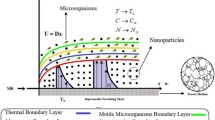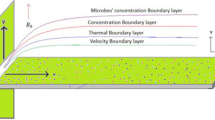Abstract
Bioconvection research is essential due to its widespread use in the domains of biofuels and bioengineering. This study investigates the numerical behavior of megnetohydrodynamic bioconvection boundary layer flow of motile microorganisms in upper convected Maxwell fluid via a renewed bvp4c-based Lobatto IIIA solver. To stabilize the nanoparticles in suspension, microorganisms are used that cause bioconvection. The flow past stretchable sheets is under the influence of heat and mass transfer, nonlinear thermal radiation, and viscous dissipation. Suitable similarity transformations are adopted to amend PDEs’ system of governing equations into ODEs’ system. Visualize graphical and numerical presentations that show the influence of physical parameters, such as flow rate, temperature gradient, nanofluid concentration, and gyrotactic motile microorganism concentration. Physical quantities such as skin friction, Nusselt number, Sherwood number, and local density of microorganisms are also taken into consideration.

























Similar content being viewed by others
Data availability
All data used in this manuscript have been presented within the article.
References
Choi SU, Eastman J. Enhancing thermal conductivity of fluids with nanoparticles (No ANL/MSD/CP-84938; CONF-951135-29). IL: Argonne National Lab; 1995.
Khan WA, Gorla RSR. Heat and mass transfer in non-Newtonian nanofluids over a non-isothermal stretching wall. Proc Inst Mech Eng Part N J Nano Eng Nano Syst. 2011;225:155–63.
Dehghani MS, Toghraie D, Mehmandoust B. Effect of MHD on the flow and heat transfer characteristics of nanofluid in a grooved channel with internal heat generation. Int J Numer Meth Heat Fluid Flow. 2018;29(4):1403–31.
Toghraie D. Numerical simulation on MHD mixed convection of Cu-water nanofluid in a trapezoidal lid-driven cavity. Int J Appl Electromagn Mech. 2020;62(4):683–710.
Talebizadehsardari P, Shahsavar A, Toghraie D, Barnoon P. An experimental investigation for study the rheological behavior of water–carbon nanotube/magnetite nanofluid subjected to a magnetic field. Phys A. 2019;534:122129.
Sheikholeslami M, Soleimani S, Ganji DD. Effect of electric field on hydrothermal behavior of nanofluid in a complex geometry. J Mol Liq. 2016;213:153–61.
Rashidi MM, Yang Z, Awais M, Nawaz M, Hayat T. Generalized magnetic field effects in Burgers’ nanofluid model. PLoS ONE. 2017;12(1):e0168923.
Khan NS, Zuhra S, Shah Q. Entropy generation in two phase model for simulating flow and heat transfer of carbon nanotubes between rotating stretchable disks with autocatalysis chemical reaction. Appl Nanosci. 2019;9(8):1797–822.
Khan NS, Gul T, Kumam P, Shah Z, Islam S, Khan W, Zuhra S, Sohail A. Influence of inclined magnetic field on Carreau nanoliquid thin film flow and heat transfer with graphene nanoparticles. Energies. 2019;12(8):1459.
Bilal S, Shah IA, Akgül A, Tekin MT, Botmart T, Yahia IS. A comprehensive mathematical structuring of magnetically effected Sutterby fluid flow immersed in dually stratified medium under boundary layer approximations over a linearly stretched surface. Alex Eng J. 2022;61(12):11889–98.
Qureshi ZA, Bilal S, Khan U, Akgül A, Sultana M, Botmart T, Zahran HY, Yahia IS. Mathematical analysis about influence of Lorentz force and interfacial nano layers on nanofluids flow through orthogonal porous surfaces with injection of SWCNTs. Alex Eng J. 2022;61(12):12925–41.
Shah IA, Bilal S, Akgül A, Tekin MT, Botmart T, Zahran HY, Yahia IS. On analysis of magnetized viscous fluid flow in permeable channel with single wall carbon nano tubes dispersion by executing nano-layer approach. Alex Eng J. 2022;61(12):11737–51.
Barnoon P, Toghraie D, Dehkordi RB, Abed H. MHD mixed convection and entropy generation in a lid-driven cavity with rotating cylinders filled by a nanofluid using two phase mixture model. J Magn Magn Mater. 2019;483:224–48.
Shekaramiz M, Fathi S, Ataabadi HA, Kazemi-Varnamkhasti H, Toghraie D. MHD nanofluid free convection inside the wavy triangular cavity considering periodic temperature boundary condition and velocity slip mechanisms. Int J Therm Sci. 2021;170:107179.
Platt JA. A numerical and experimental study of the effect of meniscus shape on combined thermocapillary and natural convection flow (Doctoral dissertation, Case Western Reserve University) 1988.
Kuznetsov AV. The onset of nanofluid bioconvection in a suspension containing both nanoparticles and gyrotactic microorganisms. Int Commun Heat Mass Transf. 2010;37(10):1421–5.
Khan SU, Al-Khaled K, Aldabesh A, Awais M, Tlili I. Bioconvection flow in accelerated couple stress nanoparticles with activation energy: bio-fuel applications. Sci Rep. 2021;11(1):1–15.
Ahmad I, Aziz S, Ali N, Khan SU, Khan MI, Tlili I, Khan NB. Thermally developed Cattaneo-Christov Maxwell nanofluid over bidirectional periodically accelerated surface with gyrotactic microorganisms and activation energy. Alex Eng J. 2020;59(6):4865–78.
Waqas H, Khan SU, Shehzad SA, Imran M. Radiative flow of Maxwell nanofluid containing gyrotactic microorganism and energy activation with convective Nield conditions. Heat Transf Asian Res. 2019;48(5):1663–87.
Tlili I, Ramzan M, Nisa HU, Shutaywi M, Shah Z, Kumam P. Onset of gyrotactic microorganisms in MHD Micropolar nanofluid flow with partial slip and double stratification. J King Saud Univ-Sci. 2020;32(6):2741–51.
Khan NS, Shah Q, Sohail A. Dynamics with Cattaneo-Christov heat and mass flux theory of bioconvection Oldroyd-B nanofluid. Adv Mech Eng. 2020;12(7):1–20.
Zuhra S, Khan NS, Alam M, Islam S, Khan A. Buoyancy effects on nanoliquids film flow through a porous medium with gyrotactic microorganisms and cubic autocatalysis chemical reaction. Adv Mech Eng. 2020;12(1):1687814019897510.
Shateyi S, Motsa SS. Variable viscosity on magnetohydrodynamic fluid flow and heat transfer over an unsteady stretching surface with Hall effect. Bound Value Probl. 2010;2010:1–20.
Kumari M, Nath G. Steady mixed convection stagnation-point flow of upper convected Maxwell fluids with magnetic field. Int J Non-Linear Mech. 2009;44(10):1048–55.
Saleem S, Awais M, Nadeem S, Sandeep N, Mustafa MT. Theoretical analysis of upper-convected Maxwell fluid flow with Cattaneo-Christov heat flux model. Chin J Phys. 2017;55(4):1615–25.
Liao S. On the homotopy analysis method for nonlinear problems. Appl Math Comput. 2004;147(2):499–513.
Marinca V, Herişanu N, Nemeş I. Optimal homotopy asymptotic method with application to thin film flow. Open Phys. 2008;6(3):648–53.
He JH. Homotopy perturbation method: a new nonlinear analytical technique. Appl Math Comput. 2003;135(1):73–9.
Wazwaz AM. A reliable modification of Adomian decomposition method. Appl Math Comput. 1999;102(1):77–86.
Zienkiewicz OC, Taylor RL. The finite element method, vol. 2. Oxford: Butterworth-Heinemann; 2000.
Liszka T, Orkisz J. The finite difference method at arbitrary irregular grids and its application in applied mechanics. Comput Struct. 1980;11(1–2):83–95.
Butcher JC. On the implementation of implicit Runge-Kutta methods. BIT Numer Math. 1976;16(3):237–40.
Shampine LF, Kierzenka J, Reichelt MW. Solving boundary value problems for ordinary differential equations in MATLAB with bvp4c. Tutor Notes. 2000;2000:1–27.
Nagoor AH, Alaidarous ES, Sabir MT, Shoaib M, Raja MAZ. Numerical treatment for three-dimensional rotating flow of carbon nanotubes with Darcy-Forchheimer medium by the Lobatto IIIA technique. AIP Adv. 2020;10(2):025016.
Khan WU, He Y, Raja MAZ, Chaudhary NI, Khan ZA, Shah SM. Flower pollination heuristics for nonlinear active noise control systems. CMC-Comput Mater Contin. 2021;67(1):815–34.
Ilyas H, Ahmad I, Raja MAZ, Tahir MB, Shoaib M. Intelligent computing for the dynamics of fluidic system of electrically conducting Ag/Cu nanoparticles with mixed convection for hydrogen possessions. Int J Hydrog Energy. 2021;46(7):4947–80.
Sabir Z, Raja MAZ, Wahab HA, Shoaib M, Aguilar JG. Integrated neuro‐evolution heuristic with sequential quadratic programming for second‐order prediction differential models. Numer Methods Partial Differ Equ 2020.
Umar M, Sabir Z, Raja MAZ, Amin F, Saeed T, Sanchez YG. Integrated neuro-swarm heuristic with interior-point for nonlinear SITR model for dynamics of novel COVID 19. Alex Eng J. 2021;60(3):2811–24.
Iqbal MS, Yasin MW, Ahmed N, Akgül A, Rafiq M, Raza A. Numerical simulations of nonlinear stochastic Newell-Whitehead-Segel equation and its measurable properties. J Comput Appl Math. 2023;418:114618.
Attia N, Akgül A, Seba D, Nour A, Asad J. A novel method for fractal-fractional differential equations. Alex Eng J. 2022;61(12):9733–48.
Farman M, Akgül A, Tekin MT, Akram MM, Ahmad A, Mahmoud EE, Yahia IS. Fractal fractional-order derivative for HIV/AIDS model with Mittag-Leffler kernel. Alex Eng J. 2022;61(12):10965–80.
Modanli M, Göktepe E, Akgül A, Alsallami SA, Khalil EM. Two approximation methods for fractional order Pseudo-Parabolic differential equations. Alex Eng J. 2022;61(12):10333–9.
Xu C, Farman M, Hasan A, Akgül A, Zakarya M, Albalawi W, Park C. Lyapunov stability and wave analysis of Covid-19 omicron variant of real data with fractional operator. Alex Eng J. 2022;61(12):11787–802.
Renardy M. High Weissenberg number boundary layers for the upper converted Maxwell fluid. J Nonnewton Fluid Mech. 1997;68(1):125–32.
Sadeghy K, Hajibeygi H, Taghavi S. Stagnation-point flow of upper-convected Maxwell fluids. Int J Non-Linear Mech. 2006;41(10):1242–7.
Pedley TJ, Kessler JO. Hydrodynamic phenomena in suspensions of swimming microorganisms. Annu Rev Fluid Mech. 1992;24(1):313–58.
Ramzan M, Bilal M, Farooq U, Chung JD. Mixed convective radiative flow of second grade nanofluid with convective boundary conditions: an optimal solution. Results Phys. 2016;6:796–804.
Acknowledgements
The authors extend their appreciation to the Deanship of Scientific Research at King Khalid University, Abha, Saudi Arabia, for funding this work through the Research Group Project under Grant Number (RGP.2/300/44).
Author information
Authors and Affiliations
Corresponding author
Ethics declarations
Conflict of interest
The authors have no conflict of interest.
Additional information
Publisher's Note
Springer Nature remains neutral with regard to jurisdictional claims in published maps and institutional affiliations.
Rights and permissions
Springer Nature or its licensor (e.g. a society or other partner) holds exclusive rights to this article under a publishing agreement with the author(s) or other rightsholder(s); author self-archiving of the accepted manuscript version of this article is solely governed by the terms of such publishing agreement and applicable law.
About this article
Cite this article
Algehyne, E.A., Zuhra, S., Raizah, Z. et al. MHD gyrotactic microorganisms upper convected Maxwell fluid flow in the presence of nonlinear thermal radiation: numerical approach Lobatto IIIA technique. J Therm Anal Calorim 148, 6791–6805 (2023). https://doi.org/10.1007/s10973-023-12204-2
Received:
Accepted:
Published:
Issue Date:
DOI: https://doi.org/10.1007/s10973-023-12204-2




